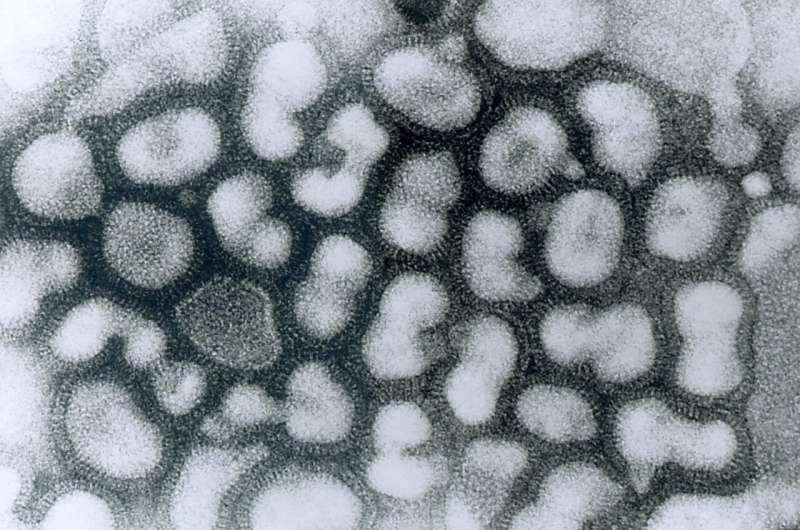Lactic acid bacteria can protect against Influenza A virus, study finds

Lactic acid bacteria, commonly used as probiotics to improve digestive health, can offer protection against different subtypes of influenza A virus, resulting in reduced weight loss after virus infection and lower amounts of virus replication in the lungs, according to a study led by Georgia State University.
Influenza virus can cause severe respiratory disease in humans. Although vaccines for seasonal influenza viruses are readily available, influenza virus infections cause three to five million life-threatening illnesses and 250,000 to 500,000 deaths worldwide during epidemics. Pandemic outbreaks and air transmission can rapidly cause severe disease and claim many more human lives worldwide. This occurs because current vaccines are effective only when vaccine strains and circulating influenza viruses are well matched.
Influenza A virus, which infects humans, birds and pigs, has many different subtypes based on hemagglutinin (HA) and neuraminidase (NA) proteins on the surface of the virus. There are 18 different HA and 11 different NA subtype molecules identified, which indicates numerous HA and NA influenza virus combinations. As a result, it's important to find ways to provide broad protection against influenza viruses, regardless of the virus strain.
Fermented vegetables and dairy products contain a variety of lactic acid bacteria, which have a number of health benefits in addition to being used as probiotics. Studies have found some lactic acid bacteria strains provide partial protection against bacterial infectious diseases, such as Streptococcus pneumoniae, as well as cold and influenza viruses.
This study investigated the antiviral protective effects of a heat-killed strain of lactic acid bacteria, Lactobacillus casei DK128 (DK128), a promising probiotic isolated from fermented vegetables, on influenza viruses.
Mice pretreated with DK128 intranasally and infected with influenza A virus showed a variety of immune responses that are correlated with protection against influenza virus, including an increase in the alveolar macrophage cells in the lungs and airways, early induction of virus specific antibodies and reduced levels of pro-inflammatory cytokines and innate immune cells. The mice also developed immunity against secondary influenza virus infection by other virus subtypes. The findings are published in the journal Scientific Reports.
"We found that pretreating the mice with heat-killed Lactobacillus casei DK128 bacteria made them resistant to lethal primary and secondary influenza A virus infection and protected them against weight loss and mortality," said Dr. Sang-Moo Kang, lead author of the study and professor in the Institute for Biomedical Sciences at Georgia State. "Our results are highly significant because mice pretreated with DK128 had 100 percent survival and prevention of weight loss. This strain of lactic acid bacteria also equipped mice with cross-protective immunity against secondary lethal infection with influenza virus. Protection against influenza virus infection was not specific to a particular strain of influenza.
"Our study provides evidence that heat-killed lactic acid bacteria could potentially be administered via a nasal spray as a prophylactic drug against non-specific influenza virus infections."
The researchers pretreated mice intranasally with heat-killed DK128 and then infected them with a lethal dose of influenza A virus, subtype H3N2 or H1N1. Mice pretreated with a low dose of DK128 showed 10 to 12 percent weight loss, but survived the lethal infection of H3N2 or H1N1 virus. In contrast, mice pretreated with a higher dose of heat-killed DK128 did not show weight loss. Control mice, which were not pretreated with DK128, showed severe weight loss by days eight and nine of the infection and all of these mice died.
Mice that received heat-killed lactic acid bacteria (DK128) prior to infection had about 18 times less influenza virus in their lungs compared to control mice.
Next, the researchers tested protection against secondary influenza virus infection by infecting pretreated mice with a different influenza A subtype from their primary virus infection. For the secondary virus infection, mice were exposed to H1N1 or rgH5N1.
The study's results suggest that pretreatment with lactic acid bacteria, specifically DK128, equips mice with the capacity to have protective immunity against a broad range of primary and secondary influenza A virus infections.
More information: Yu-Jin Jung et al. Heat-killed Lactobacillus casei confers broad protection against influenza A virus primary infection and develops heterosubtypic immunity against future secondary infection, Scientific Reports (2017). DOI: 10.1038/s41598-017-17487-8

















